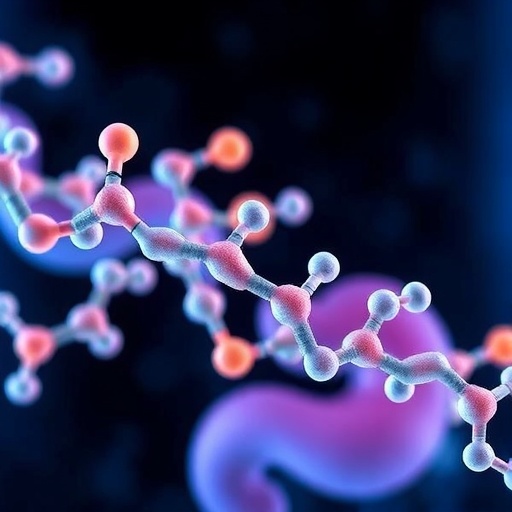Pancreatic cancer remains one of the deadliest malignancies worldwide, notorious for its stealthy onset and rapid progression. Despite advances in oncology, this disease’s mortality rate continues to rise, largely because early detection is challenging and therapeutic options remain limited. In a groundbreaking study jointly conducted by researchers at the Salk Institute and the University of California San Diego, a novel molecular player has been identified that may revolutionize the approach to pancreatic ductal adenocarcinoma (PDAC), the predominant form of pancreatic cancer. This molecule, an antithrombin-binding heparan sulfate variant termed HSAT, emerges as both a critical suppressor of tumor progression and a promising biomarker for early diagnosis.
The complexity of pancreatic cancer lies in its cellular microenvironment and the biochemical signals that govern tumor survival and metastasis. Cancer cells are notorious for reprogramming their surface molecular landscape, particularly through alterations in sugar molecules known as glycans. These sugar moieties are not mere decorations; they actively mediate cancer cell interactions with their surroundings, including immune evasion and cellular communication. Among these, heparan sulfate—a glycosaminoglycan—has been implicated in shielding pancreatic cancer cells from immunological attack and contributing to resistance against contemporary immunotherapies. The identification of HSAT, a specific modification of heparan sulfate that binds antithrombin, sheds new light on the dual role glycans play in both coagulation and cancer biology.
At the molecular level, antithrombin is a pivotal protein controlling blood coagulation by inactivating thrombin and other proteases in the clotting cascade. Activation of antithrombin necessitates its interaction with specialized heparan sulfate sequences featuring the HSAT motif. Clinically, heparin—an anticoagulant extensively used in medical practice—mimics this interaction through its structural similarity to HSAT-bearing heparan sulfate chains. This biochemical parallel raises intriguing questions about the interplay between coagulation pathways and pancreatic tumor biology, as cancer patients often suffer from hypercoagulability and increased thrombotic risk.
The research team, led by co-senior author Dannielle Engle and colleagues from Salk and UC San Diego, discovered that contrary to previous beliefs, HSAT is abundantly expressed in epithelial cells across multiple organs, especially within pancreatic tissues both healthy and cancerous. Their investigations revealed that HSAT levels are particularly elevated in early-stage pancreatic lesions but diminish as tumors advance. This dynamic expression pattern suggests that HSAT plays a vital protective role in the pancreas, which is progressively lost during malignant transformation. By analyzing patient-derived samples alongside genetically engineered mouse models, the researchers demonstrated that HSAT deficiency correlates with heightened inflammation, increased tumor survival, and a striking doubling in metastatic frequency.
To elucidate the mechanisms underpinning HSAT’s tumor-suppressive function, the study delved into its influence on the thrombin/PAR-1 signaling axis. PAR-1, a protease-activated receptor, modulates the crosstalk between coagulation and inflammation—two processes intimately linked to cancer progression. By preserving HSAT expression, the balance of this axis is maintained, thus restraining the pro-inflammatory and pro-metastatic milieu within the pancreatic microenvironment. Conversely, loss of HSAT unleashes unchecked thrombin activity, fostering an environment conducive to tumor growth and dissemination.
The translational implications of these findings are profound. Augmenting HSAT levels or mimicking its function pharmacologically could simultaneously mitigate hypercoagulability—a significant risk factor for cancer-related morbidity—and suppress tumor metastasis. This dual-action strategy holds exceptional promise in improving patient outcomes, particularly given the limited efficacy of existing treatments for PDAC. Moreover, the detection of HSAT in plasma samples offers a non-invasive avenue to monitor tumor progression and potentially identify pancreatic cancer at an earlier, more treatable stage.
Importantly, the study underscores a paradigm shift in glycoscience and cancer biology by emphasizing the ubiquity and functional importance of HSAT beyond the pancreas. While the immediate focus remains on PDAC, similar glycan-mediated regulatory mechanisms might be operative in other epithelial cancers, opening new horizons for broader oncological research and therapeutic development.
The collaboration between experts in sugar biology, cancer research, and clinical sciences enabled a comprehensive interrogation of HSAT’s role at molecular, cellular, and systemic levels. By integrating patient tissue analysis, murine models, and plasma biomarker studies, the team provided compelling evidence that HSAT is not an ancillary molecule but a central modulator of pancreatic tumorigenesis.
As the investigation progresses, future studies will aim to refine methods to elevate HSAT expression safely in patients and further detail the molecular pathways influenced by HSAT-dependent signaling. This could pave the way for innovative drugs that harness the body’s own biochemical arsenal to combat pancreatic cancer’s lethality, as well as for diagnostic tools that leverage HSAT’s presence in bodily fluids.
The urgency of addressing pancreatic cancer’s high mortality cannot be overstated. Early detection, better understanding of tumor biology, and effective targeted therapies are critical unmet needs. This study represents a landmark advance by uncovering a naturally occurring glycan modification with the potential to reshape both diagnostic and therapeutic landscapes.
Together, these findings mark a new frontier in the fight against pancreatic cancer, blending insights from glycobiology, hematology, and oncology. The prospect of harnessing HSAT to suppress tumor progression while reducing thrombotic complications offers a hopeful beacon for patients and clinicians grappling with this formidable disease. The scientific community eagerly anticipates further exploration of HSAT’s multifaceted role and its translation into clinical practice.
Subject of Research: Pancreatic ductal adenocarcinoma and the role of antithrombin-binding heparan sulfate (HSAT) in tumor progression and metastasis.
Article Title: Antithrombin-binding heparan sulfate is ubiquitously expressed in epithelial cells and suppresses pancreatic tumorigenesis.
News Publication Date: September 16, 2025.
Web References:
Journal of Clinical Investigation Article
DOI: 10.1172/JCI184172
Image Credits: Salk Institute
Keywords: Pancreatic cancer, heparan sulfate, HSAT, tumor progression, metastasis, biomarker, glycobiology, antithrombin, blood coagulation, thrombin, PAR-1 signaling, immunotherapy, cancer biology




